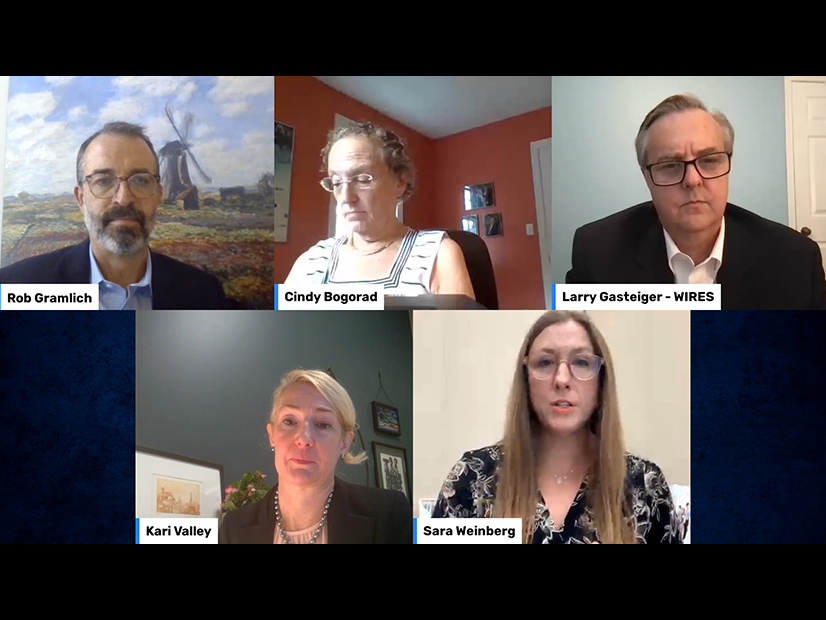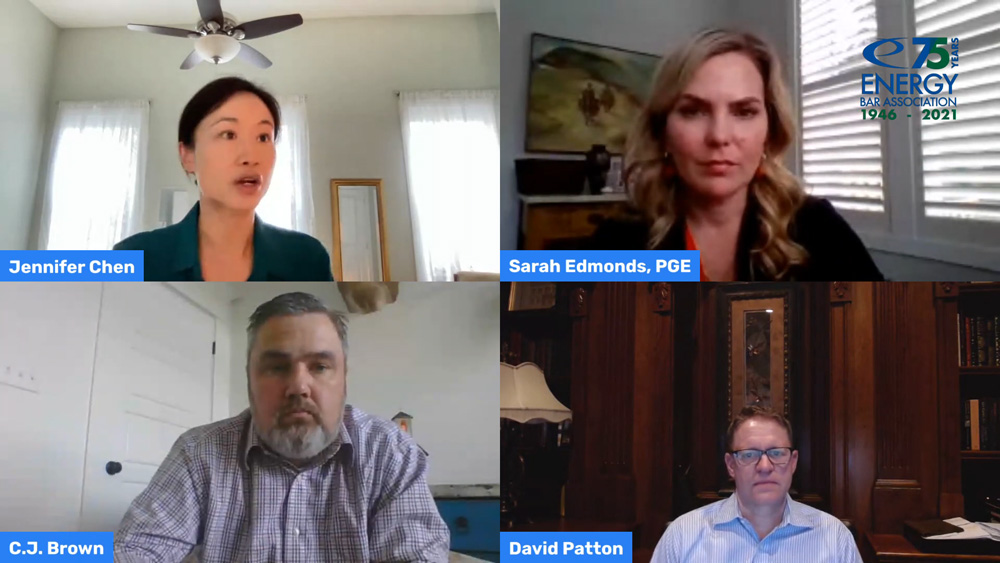
The Energy Bar Association last week once again gathered online, this time for its annual Mid-Year Forum, to discuss carbon capture, environmental justice and electric vehicle infrastructure.
Dan Sutherland, chief counsel for the Cybersecurity and Infrastructure Security Agency, kicked off the two-day event Oct. 12 with a keynote speech and discussion, followed by a panel on cybersecurity risks for the energy industry. (See related story, EBA Panel Discusses Management and Mitigation of Cybersecurity Risks.) But the first day also featured two panels on transmission, with one on FERC’s Advance Notice of Proposed Rulemaking (ANOPR) into planning and cost allocation, and another focusing on interregional coordination and operations.
Here’s some of what we heard.
A New Order Needed?
The first transmission panel focused on FERC’s ANOPR, which sought comments on possible changes to its rules on transmission planning and generator interconnection (RM21-17). Coincidentally, the session took place on the day comments were due; about 170 companies and groups weighed in. (See related story, FERC Tx Inquiry: Consensus on Need for Change, Discord Over Solutions.)
The EBA discussion was a microcosm of the debates that played out through those comments.
Moderator Larry Gasteiger, executive director of WIRES, slyly posed “a simple question” for the panel to answer: Is transmission planning working?
Kari Valley, managing senior corporate counsel for MISO, returned a definitive “yes,” though she admitted that there is room for improvement. “We’re always looking at where we can address the issues being presented today and the issues that we see in the future,” she said, pointing to the RTO’s past success with its Multi-Value Project portfolio and its effort to address the massive influx of renewables with its long-range transmission plan.
Sara Weinberg, senior counsel for Dominion Energy, disagreed. “Fundamentally, the regulatory paradigm that we have in place for both transmission planning and generator interconnection is flawed,” she said. “It’s just antiquated. And it’s obviously not in line with the things that we need to be doing right now to move to a cleaner energy future.”
Weinberg noted that Dominion serves load in both RTO and non-RTO footprints and said transmission planners work reactively, building transmission to interconnect resources that are in interconnection queues, rather than “looking at everything in a holistic fashion.”
Cynthia Bogorad, a partner at Spiegel & McDiarmid, said she would be filing comments later that day for her client, the Transmission Access Policy Study Group (TAPS). Echoing many comments in the FERC docket — not just TAPS’ — Bogorad said that “a more holistic approach, while it sounds good, has its own problems [that] we’re going to have to tackle. One is [that] a one-size-fits-all approach is not going to be the answer.”
Rob Gramlich, president of Grid Strategies and eternal optimist for improved transmission planning policy, was upbeat as he gave a presentation on the history of FERC’s efforts regarding the issue and his organization’s proposal. One of his slides listed the commission’s orders regarding transmission and interconnection: 888 (1996), 2000 (1999), 890 (2007) and 1000 (2011). The last bullet listed “??? (2022?).”
Western Independence and Incrementalism
Jennifer Chen, president of consultancy ReGrid and moderator of the second panel, began by thanking attendees for joining “even though your FERC transmission ANOPR comments are due today before 5 p.m.” Her session also provided a miniature version of recent discussions, in this case those among Western energy organizations and state legislatures. (See related story, Talk of Western RTO Intensifies.)
 Clockwise from top left: Jennifer Chen, ReGrid; Sarah Edmonds, PGE; David Patton, Potomac Economics; and C.J. Brown, SPP | EBA
Clockwise from top left: Jennifer Chen, ReGrid; Sarah Edmonds, PGE; David Patton, Potomac Economics; and C.J. Brown, SPP | EBA“There’s a lot going on in the West,” acknowledged Sarah Edmonds, director of transmission and market services for Portland General Electric. “It’s very easy at times, especially for an observer from the outside, to ask, ‘Why don’t they just do an RTO? Why do they have to do this very unique, incremental approach?’ … Our last 20-year-plus of history is marked by the tombstones of several failed attempts in the RTO space.”
There are many reasons for these failures, but “it’s fundamentally been about trust and control,” said Edmonds, whose office was adorned with a painting of two horseback riders riding along a dirt trail.
“There’s a deeply ingrained Western culture of self-determination and independence. We have a long tradition of operating our own balancing authority areas … of relying on ourselves and feeling like, ‘We know our systems best, and we know how to flex our systems to keep the lights on for our customers.’”
CAISO’s Western Energy Imbalance Market began eroding utilities’ stubbornness, she said. With Bonneville Power Administration’s entry into the market next year, more than 80% of WECC (which covers the entire Western Interconnection except for Alberta) will be served by the EIM.
Edmonds also spoke about the unique challenges to building transmission in the West, including wide areas of tribal land and endangered species habitat. “There’s a lot of trepidation in Western hearts, minds and wallets about what transmission cost allocation could mean to customers. This is why I think it’s been one of the hardest things to solve.”
David Patton — whose firm Potomac Economics serves as market monitor for ERCOT, ISO-NE, MISO and NYISO — said his primary concern was that grid operators “don’t fully use the transmission that we have today.” Many transmission owners don’t use ambient-adjusted or dynamic line ratings to increase capacity as conditions change and “don’t provide appropriate emergency ratings, which basically means that the system can be more congested than it needs to be, and it can cause you to believe that high-voltage transmission is more valuable than it actually is.”
But “in certain places, especially places [where] the wind is just exploding” — such as SPP, whose director of systems operations, C.J. Brown, nodded along as Patton spoke — “high-voltage facilities are going to be the most economical,” Patton said.
Brown responded by quoting MISO CEO John Bear: “‘If you like renewables, you better like transmission.’”


